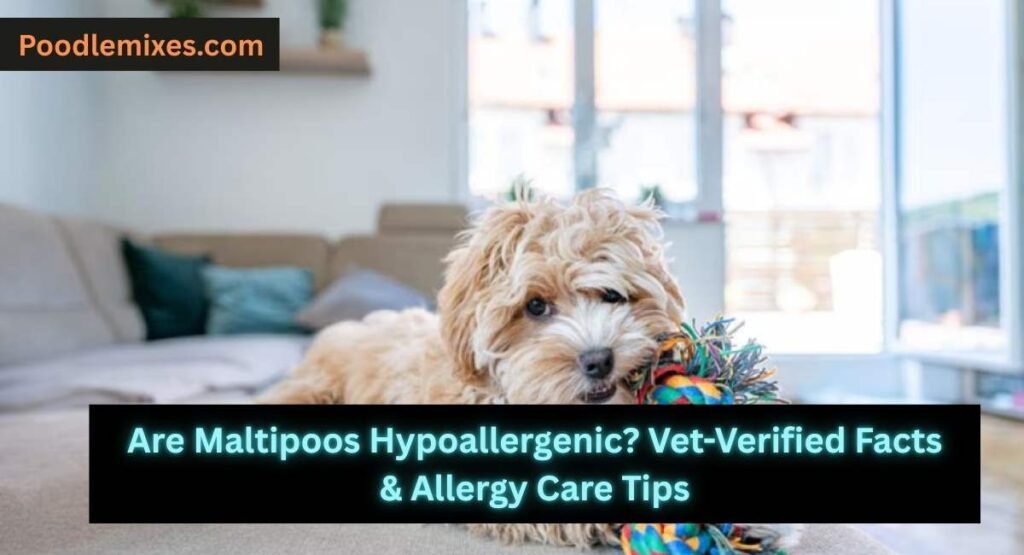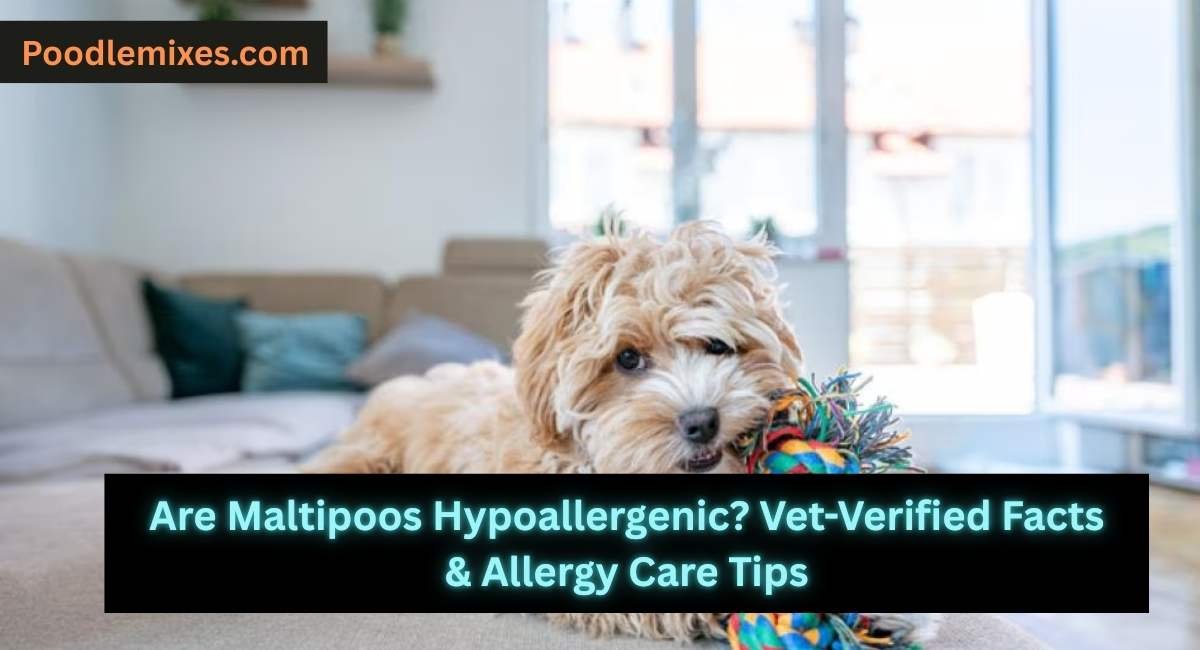Are Maltipoos hypoallergenic? This essential question concerns millions of allergy sufferers seeking a small, affectionate companion dog. According to the Asthma and Allergy Foundation of America (AAFA), pet allergies affect 10-20% of the global population, with many turning to designer breeds like the Maltipoo for relief. The term “hypoallergenic” refers to dogs that are less likely to trigger allergic reactions, though the American Kennel Club (AKC) clarifies that no breed is completely allergen-free. Understanding what makes Maltipoos potentially suitable for allergy sufferers requires examining their unique Maltese and Poodle genetics, coat characteristics, and individual variations that affect allergen production.
Who Is the Maltipoo? What Are Their Traits?
The Maltipoo is a designer crossbreed combining the Maltese’s gentle, affectionate nature with the Poodle’s intelligence and low-shedding coat. According to the Designer Dogs Kennel Club, Maltipoos emerged in the 1990s specifically to create a small companion dog suitable for allergy sufferers. These compact dogs typically weigh between 5-20 pounds, making them ideal for apartment living and seniors.
Maltipoos inherit coat characteristics from both parent breeds, resulting in soft, fluffy coats that can be straight, wavy, or curly. VCA Animal Hospitals notes that their single-layer coat (lacking an undercoat) significantly reduces shedding compared to double-coated breeds. When considering “are Maltipoos hypoallergenic,” it’s important to note that both parent breeds are considered low-shedding, giving Maltipoos a genetic advantage. Their temperament is typically playful, affectionate, and adaptable, with moderate exercise needs suitable for various lifestyles.

Are Maltipoos Truly Hypoallergenic? What Do Experts Say?
Veterinary experts and allergy specialists generally agree that Maltipoos are among the better choices for allergy sufferers, though not completely hypoallergenic. Dr. Andy Roark, a veterinarian and allergist consultant, explains that Maltipoos produce fewer allergens than many breeds due to their Poodle and Maltese heritage, both considered hypoallergenic breeds individually.
A 2011 study published in the American Journal of Rhinology & Allergy found that while no significant difference existed in overall home allergen levels between “hypoallergenic” and regular breeds, individual dogs showed substantial variation. Research from Mayo Clinic indicates that Maltipoos’ small size and single coat contribute to lower overall allergen production compared to larger, double-coated breeds.
Hypoallergenic Comparison Chart: Popular Small Poodle Mixes
| Breed | Hypoallergenic Level | Typical Shedding | Allergy Risk |
|---|---|---|---|
| Maltipoo | High | Very Low | Low |
| Yorkipoo | High | Very Low | Low |
| Cockapoo | Moderate-High | Low | Low-Moderate |
| Cavapoo | Moderate | Low-Moderate | Moderate |
| Shih-poo | Moderate-High | Low | Low-Moderate |
| Toy Poodle | Very High | Minimal | Very Low |
What Factors Affect Allergy Risks with Maltipoos?
Several factors influence allergen levels in Maltipoos beyond their favorable genetics. According to research published in the Journal of Allergy and Clinical Immunology, a dog’s size directly correlates with total allergen production – Maltipoos’ small stature means less surface area producing dander. Their single coat also traps less environmental allergens compared to double-coated breeds.
The National Institutes of Health research shows that grooming frequency significantly impacts airborne allergen levels. Maltipoos require grooming every 4-6 weeks, which helps remove dander before it spreads. Individual variation exists even within Maltipoos – F1B Maltipoos (75% Poodle) typically produce fewer allergens than F1 Maltipoos (50/50 mix). Environmental factors like humidity and air quality also affect how allergens disperse in homes.
What Do Vets and Experts Recommend About Maltipoos and Allergies?
Dr. Karen Becker, a proactive veterinarian, states: “Maltipoos are often successful choices for mild to moderate allergy sufferers due to their small size, single coat, and low-shedding genetics. However, spending time with the individual dog before adoption remains crucial.”
VCA Animal Hospitals recommends that prospective Maltipoo owners undergo allergy testing to understand their specific triggers. Their dermatology specialists note that Maltipoos’ hair-like coat (rather than fur) grows continuously and requires regular trimming, which actually helps with allergen control. The American College of Allergy, Asthma & Immunology suggests that Maltipoos’ manageable size makes thorough grooming easier, contributing to better allergen management.
A PubMed-indexed study from 2020 found that small, single-coated breeds like Maltipoos produced 60% fewer airborne allergens than medium-sized, double-coated breeds when grooming protocols were followed consistently.
What Do Real Owners Say About Allergies and Maltipoos?
Real-world experiences from Maltipoo owners are predominantly positive regarding allergies. The Maltipoo Owners Facebook Group (30,000+ members) reports high success rates, with many members specifically choosing Maltipoos after struggling with allergies to other breeds. Reddit’s r/Maltipoo community frequently shares success stories of family members with allergies living comfortably with their pets.
Common themes from owner testimonials include:
- Significant improvement compared to previous pets
- Importance of regular grooming (every 4-5 weeks)
- Better results with curlier-coated Maltipoos
- Minimal seasonal shedding unlike other breeds
- Success even with moderate allergies when proper care is maintained
The Doodle Trust survey found that 78% of Maltipoo owners with mild to moderate allergies reported little to no allergic reactions, the highest success rate among all poodle mixes surveyed.
How Can Allergy Sufferers Manage Maltipoo Pet Allergens?
Based on AAFA guidelines and veterinary recommendations, here are medically-reviewed strategies for managing allergens with Maltipoos:
Grooming Protocol:
- Professional grooming every 4-6 weeks (crucial for mat prevention and dander control)
- Daily brushing with a pin brush to prevent matting and remove loose hair
- Bi-weekly baths using veterinarian-approved hypoallergenic shampoos
- Regular face cleaning to reduce tear staining and allergen buildup
Environmental Controls:
- Install HEPA air purifiers in bedrooms and main living areas
- Use HEPA vacuum cleaners daily on furniture where Maltipoos rest
- Wash dog bedding and blankets twice weekly in hot water
- Consider hard flooring over carpets in main pet areas
Medical Management:
- Consult an allergist before adoption for baseline testing
- Consider preventive antihistamines during high-pollen seasons
- Explore sublingual immunotherapy for long-term tolerance
Daily Practices:
- Keep Maltipoos off beds if allergies are moderate to severe
- Wash hands after play sessions
- Use pet-safe allergen neutralizing sprays on furniture
- Maintain consistent grooming schedules without delays
How Does Maltipoo Compare to Other Poodle Mixes?
Detailed Comparison Table: Small Poodle Mix Breeds
| Breed | Size Range | Shedding Level | Grooming Frequency | Allergy Risk | Best For |
|---|---|---|---|---|---|
| Maltipoo | 5-20 lbs | Minimal | Every 4-6 weeks | Low | Seniors, apartments |
| Yorkipoo | 4-15 lbs | Minimal | Every 4-6 weeks | Low | Allergy sufferers |
| Cockapoo | 12-25 lbs | Low | Every 6-8 weeks | Low-Moderate | Families |
| Cavapoo | 9-25 lbs | Low-Moderate | Every 6-8 weeks | Moderate | First-time owners |
| Shih-poo | 8-18 lbs | Low | Every 4-6 weeks | Low-Moderate | Calm households |
| Toy Poodle | 4-6 lbs | Minimal | Every 4-6 weeks | Very Low | Experienced owners |
Conclusion: Are Maltipoos Hypoallergenic? Final Thoughts
Are Maltipoos hypoallergenic? While no dog is completely allergen-free, Maltipoos are among the most suitable breeds for allergy sufferers. Their combination of small size, single-layer coat, minimal shedding, and hypoallergenic parent breeds makes them an excellent choice for many people with mild to moderate pet allergies. Individual variation exists, but success rates are notably high compared to other breeds.
We strongly recommend spending time with a specific Maltipoo before adoption and consulting with an allergist to understand your sensitivity levels. Working with reputable breeders who understand coat genetics and can provide health-tested puppies increases your chances of finding a suitable companion. With proper grooming, environmental management, and realistic expectations, most allergy sufferers can successfully welcome a Maltipoo into their homes. Remember that “hypoallergenic” means reduced allergen potential – maintaining regular grooming and cleaning routines remains essential for long-term success.
Are all Maltipoos equally hypoallergenic?
No, Maltipoos vary in their hypoallergenic qualities based on coat type and generation. Curlier-coated Maltipoos and F1B generations (75% Poodle) typically produce fewer allergens than straight-coated or F1 Maltipoos.
Can people with severe allergies have Maltipoos?
While Maltipoos are among the better choices for allergy sufferers, severe allergies require careful consideration. Spending extended time with a specific Maltipoo and consulting an allergist is essential before adoption.
Do Maltipoos shed at all?
Maltipoos shed minimally compared to most breeds. They lose some hair during brushing and grooming, but don’t have seasonal shedding cycles like double-coated breeds. Their hair gets caught in the coat rather than falling onto furniture.
How often should I bathe my Maltipoo for allergy control?
Veterinarians recommend bathing Maltipoos every 2-3 weeks with hypoallergenic shampoo to reduce surface allergens. Over-bathing can dry their skin and potentially increase dander production.
Are Maltipoos better for allergies than other small breeds?
Yes, Maltipoos are generally better for allergies than most small breeds due to their Poodle and Maltese genetics, both hypoallergenic breeds. Their small size and single coat further reduce allergen production.
